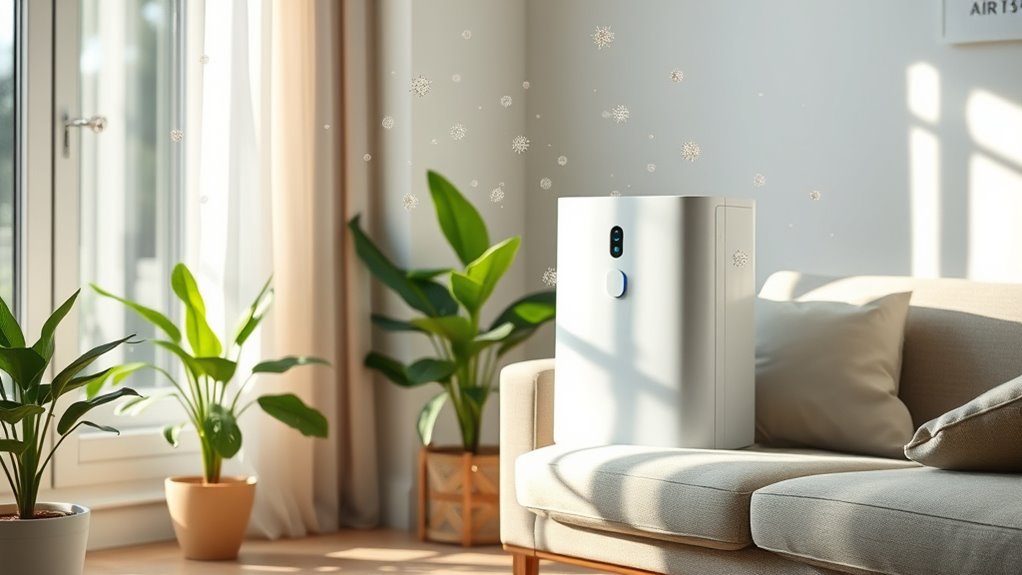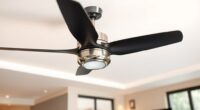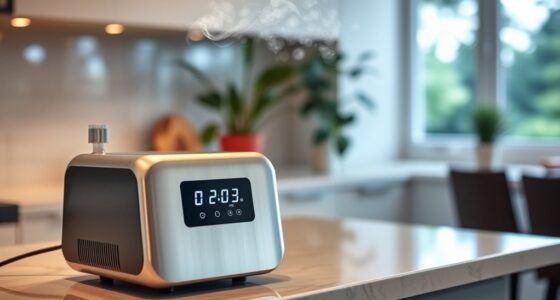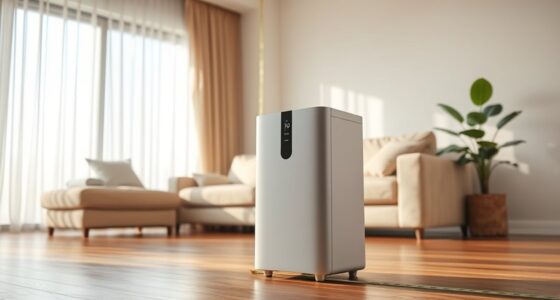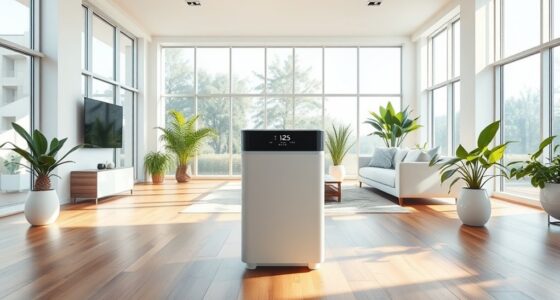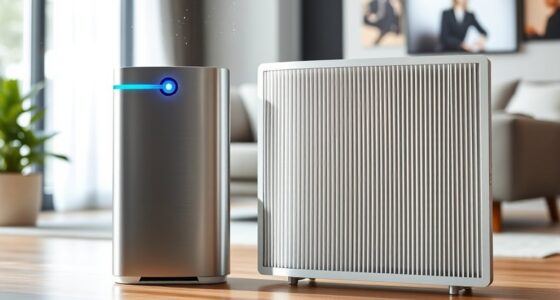Yes, air purifiers can help alleviate allergy symptoms by trapping airborne allergens like pollen, dust mites, pet dander, and mold spores with HEPA filters. They also reduce airborne irritants from VOCs using activated carbon filters, creating cleaner air and easing breathing. Proper use, such as placing them in high-traffic rooms and maintaining filters, boosts their effectiveness. To discover how to maximize these benefits, keep exploring how these devices can improve your indoor environment.
Key Takeaways
- HEPA filters effectively capture airborne allergens like pollen, dust mites, pet dander, and mold spores, reducing allergy triggers.
- Activated carbon filters remove VOCs from household products, decreasing chemical irritants that worsen allergy symptoms.
- Proper placement and continuous operation of air purifiers maintain high indoor air quality and allergen reduction.
- Using air purifiers alongside regular cleaning and allergen management enhances overall allergy relief.
- Advanced filtration technology further improves removal of airborne irritants, supporting healthier indoor environments.
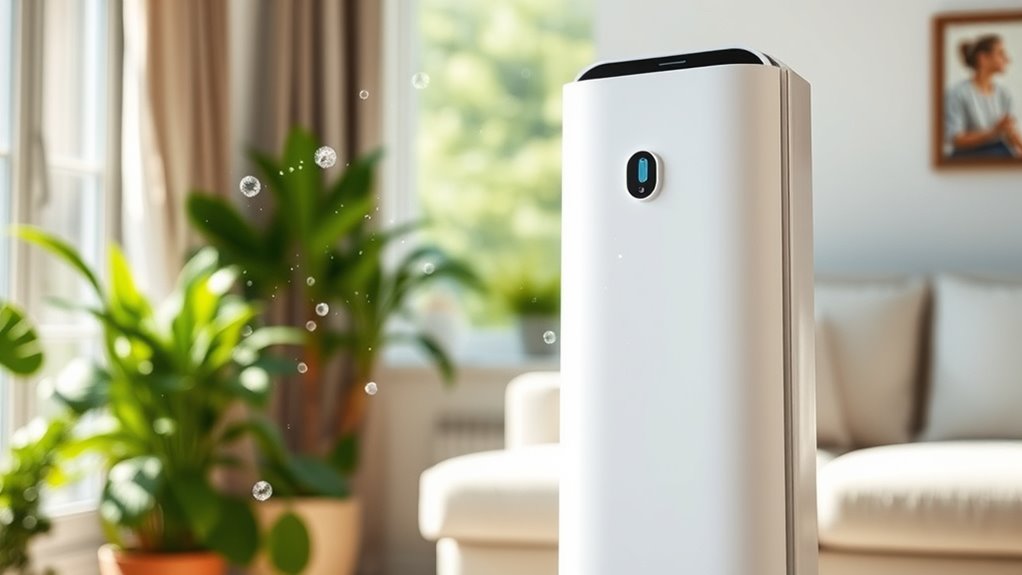
If you suffer from allergies, using an air purifier can make a noticeable difference in your daily comfort. Many allergens like pollen, dust mites, pet dander, and mold spores linger in the air, triggering sneezing, congestion, and itchy eyes. An effective air purifier helps by capturing these particles before they reach your lungs, providing relief and improving your overall well-being. The key is choosing a model equipped with HEPA filters, which are specially designed to trap tiny particles as small as 0.3 microns. HEPA filters are proven to remove a significant portion of airborne allergens, making the air around you cleaner and safer to breathe. When you run an air purifier with a HEPA filter, you actively reduce the presence of common irritants, which can lessen symptom severity and frequency over time.
Using a HEPA filter air purifier reduces airborne allergens and eases allergy symptoms effectively.
Beyond allergens, many air purifiers also feature VOC removal capabilities. Volatile organic compounds (VOCs) are chemicals emitted by household products like cleaning supplies, paints, furniture, and air fresheners. These chemicals can cause irritation and exacerbate allergy symptoms or respiratory issues. An air purifier with VOC removal technology, often involving activated carbon filters, absorbs and neutralizes these harmful gases. This means you’re not only clearing the air of visible and microscopic allergens but also reducing chemical pollutants that can worsen your allergy symptoms. When VOCs are minimized, you may notice fewer headaches, less nasal congestion, and a more comfortable indoor environment overall.
Using an air purifier with HEPA filters and VOC removal features is straightforward. Place it in the rooms where you spend the most time—your bedroom, living room, or home office—and keep it running continuously. Regular filter changes ensure peak performance; neglecting this can diminish its effectiveness. It’s also important to select a unit appropriate for your room size. A purifier that’s too small won’t adequately clean the air, while an oversized one might be unnecessary and more costly.
While an air purifier isn’t a cure-all, it’s a practical step toward alleviating allergy symptoms. It works best when combined with other allergy management strategies, such as regular cleaning, washing bedding frequently, and minimizing exposure to known triggers. Additionally, choosing a model with advanced filtration technology can further enhance its ability to remove airborne irritants. By investing in a model with HEPA filters and VOC removal capabilities, you actively improve your indoor air quality, which can lead to fewer allergy attacks and a more comfortable living space. In the end, cleaner air means better breathing, less discomfort, and a healthier home environment.
Frequently Asked Questions
Do Air Purifiers Help With Pet Allergies?
Pet allergies often cause discomfort, but air purifiers can provide allergy relief by reducing pet dander in your environment. They trap airborne particles, including pet hair, saliva, and dander, helping you breathe easier. To maximize benefits, choose an air purifier with a HEPA filter, and place it in common areas. Regularly maintaining your purifier guarantees it continues to help minimize allergy symptoms caused by pet dander.
How Often Should I Replace Filters in My Air Purifier?
Ever wondered how often you should replace your air purifier’s filters? To keep it working efficiently, check the filter lifespan and follow the recommended replacement schedule. Typically, HEPA filters need changing every 6 to 12 months, but this can vary based on usage and air quality. Regular replacements ensure your purifier effectively reduces allergens and maintains ideal performance, so don’t wait until it’s visibly dirty—stay ahead for cleaner air.
Can Air Purifiers Remove Mold Spores Effectively?
If you’re wondering whether air purifiers can remove mold spores effectively, the answer is yes, especially if they have HEPA filters designed for mold detection. However, for best results, you need proper air purifier maintenance, including regular filter replacements. Keep your space mold-free by controlling moisture and ensuring your device is functioning correctly, so mold spores are captured and don’t circulate in your indoor environment.
Are HEPA Filters Better Than Activated Carbon Filters?
You’ll find that HEPA filters are generally better than activated carbon filters for capturing airborne particles, thanks to their high HEPA efficiency in trapping allergens like pollen, dust, and pet dander. However, activated carbon filters excel at absorbing odors and chemicals. Remember, regular filter maintenance is key to keeping your air purifier working effectively. Combining both filters can provide all-encompassing allergy relief and improved indoor air quality.
Do Air Purifiers Eliminate All Airborne Allergens?
Air purifiers considerably reduce airborne particles, but they don’t eliminate all allergens completely. While they improve allergen removal, some tiny particles like pollen, pet dander, and dust mites can still linger. Using a purifier with a HEPA filter helps, but for best results, combine it with regular cleaning and dusting. Keep expectations realistic—air purifiers help, but they aren’t a complete solution for all airborne allergens.
Conclusion
Imagine your home as a sanctuary, where each inhalation feels invigorating and pure, free from sneezing fits and itchy eyes. Air purifiers act like gentle guardians, sweeping away allergens that lurk in every corner. While they might not banish every irritant, they certainly help create a healthier haven. So, if you’re tired of battling allergy symptoms, consider bringing one into your space—you’ll breathe easier, and your home will feel like a gust of fresh air.
